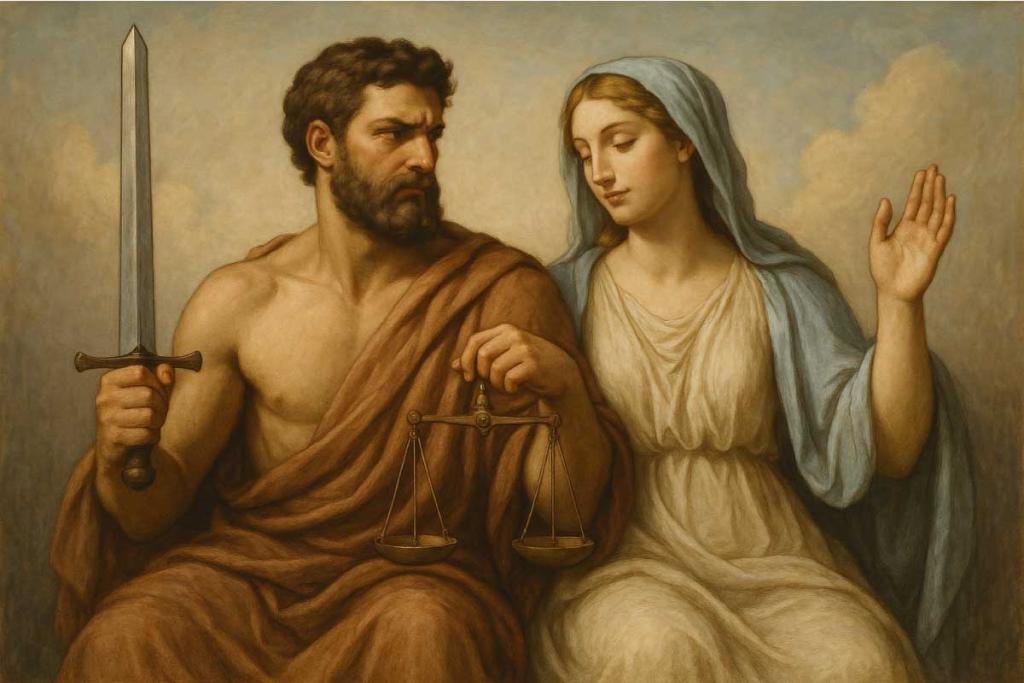
My household is in many ways similar to other homes where a Christian father and mother are doing their best to live their religion and raise kids to be disciples of Christ. Despite our efforts to teach our kids to choose the right, there are regular, even daily occurrences that require some level of parental intervention. In our home, little “fake fighting” matches among our group of young boys often result in stray, accidental elbows that quickly escalate situations into very real skirmishes. Occasionally, there is some need to reprimand our older boys too, including occasional reminders to limit screen time on phones or encouragement to be more committed to being assertive in their studies
Any time our kids get out of line, my wife and I have inherently different approaches. I tend to be inclined to hand out immediate punishment, often physically intervening to separate kids who are out of line. My wife tends to be more understanding and less aggressive in her approach to discipline and punishment, often deferring those responsibilities entirely to me.
During our catch-up chats before going to bed, my wife and I often talk about how our family is doing, which sometimes causes us to discuss our specific family circumstances and experiences, including getting philosophical about how we’re doing compared to what our religion and our consciences teach.
Our discussions about the different approaches we take toward disciplining and motivating our children, including hashing over the way we’ve handled specific discipline issues with our kids, have led us many times to the subject of how differently men and women react towards disobedience and how differently we perceive what actions should be taken towards enforcing our family rules and religious morals.
Each time I read Alma’s description of how justice and mercy interact, I’m intrigued by his assignment of masculinity to the attribute of justice while mercy is described using a feminine pronoun.
Alma 42: 24 For behold, justice exerciseth all his demands, and also mercy claimeth all which is her own; and thus, none but the truly penitent are saved.
This peculiar verse in the scriptures identifies justice as a masculine trait (“his demands”) and mercy as one associated with female characteristics (“all which are her own”). Justice is portrayed as a man who requires nothing less than that those within his jurisdiction meet the criteria for perfection that he has established. Mercy, on the other hand, acts like a woman shielding whoever she can from harsh consequences that exist because of an inability to meet the strict demands of justice.
Alma’s depiction of justice and mercy brings those seemingly incompatible traits that are associated with God, goodness, and perfection together in a way that can be more understood through the lens of the complementary roles of men and women, neither of which is complete without the other.
Adam and Eve As Examples of Justice and Mercy
The first examples we have of how men and women naturally exhibit the complementary attributes of justice and mercy can be found in Adam and Eve, mankind’s first couple.
Adam’s commitment to avoid partaking of forbidden fruit demonstrated how important it was for him to keep every aspect of the letter of the law, while Eve’s susceptibility in negotiating with the serpent and her vulnerability to the temptations and promises he offered show that she somehow knew that the transgression she would commit could somehow be atoned for, and that a divine form of mercy would make things right.
Jesus Christ’s Perfect Example
Jesus Christ’s role in the plan of salvation hinged on his living a perfect life, demonstrating by example how each who will ultimately become heirs with him should act. Although there are plenty of nuances between Jesus’ mortal experience thousands of years ago and what we deal with in modern society because of significant cultural differences, there is plenty to learn about how to master the attributes of justice and mercy, whether you are male or female.
Jesus’ life and teachings perfectly exhibited both justice and mercy in ways that are instructive for his disciples.
Most modern versions of Christianity seem to confine Jesus’ teachings to simply “don’t judge”. However, that’s not at all representative of the gospel as taught by Jesus, who went through the trouble of making his own whip to physically assault those who were desecrating the temple. Anyone who seriously reads the New Testament or the Book of Mormon accounts of Jesus’ interaction with various groups of people cannot conclude that he was only about selling mercy.
Here are some of the most direct pieces of evidence from his own life of Jesus’ sense of justice.
Matthew 10 – Jesus Not for Peace
After explaining that those who deny him would be in turn denied by him “before the Father”, Jesus makes a statement that seems to go counter to how we perceive his entire mission as the Prince of Peace:
Think not that I am come to send peace on earth: I came not to send peace, but a sword.
The peace that Jesus came to offer can only be achieved through diligent pursuit of the principles upon which peace is predicated. For those who are ultimately unwilling to acknowledge and pursue those principles, the balance will fall much more towards justice and less towards mercy.
Matthew 25 – The Unprofitable Servant
The parable of the talents described in Matthew 25:14-30 portrays Jesus’ sense of justice in a way that can be stirring. The casting of the unprofitable servant into outer darkness to experience weeping and gnashing of teeth for failing to magnify his talents demonstrates the expectation that God has for his children to be assertive in their efforts to improve. Justice will be administered even to those whose sins involve omission, who waste their time in this life with things of no worth.
But Jesus is also perfectly merciful, as demonstrated in his healing of the sick, his willingness to forgive the repentant, and his dedication to bridging the gap between justice and mercy for any who will accept it.
Jesus embodies the perfection of the interaction of justice and mercy.
Jesus forgives sin, but he demands repentance.
Jesus heals the broken, but rebukes the proud.
Jesus calls for peace, but he also sternly warns of judgment.
What Should Our Approach Be to Justice and Mercy?
I often get into trouble with my wife and others for taking it upon myself to do some catch-up work for justice, as it feels like our world has abandoned justice in favor of some distorted version of mercy. I think we will all be shocked at what happens when justice is finally administered to this world.
For now, it appears as if the powers that control this world will continue to cover up the injustices that have been done, and that the blood of the saints will continue to cry from the ground against those whose works are in the dark.
The people hiding the Epstein client list and the Diddy files, the secret combinations who are involved in perpetrating and covering up child sex abuse and other evil deeds will likely continue to have their protection for the near future.
It may very well be that there is nothing any of us can do about those things other than to pray for God to fix them and to do our best to protect those who fall within our stewardships.
For those who are interested in becoming more like the Savior, we must continue to learn from the scriptures, from the promptings of the Holy Ghost, and from life experience (including how to get along with the opposite gender in a marriage relationship) how to embody both justice and mercy.














